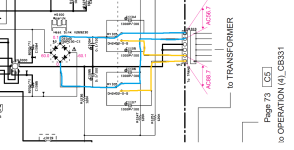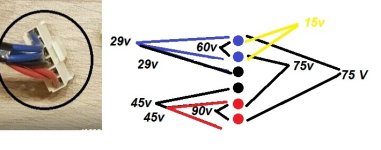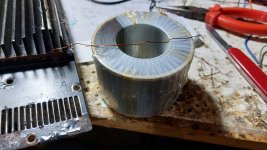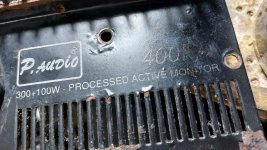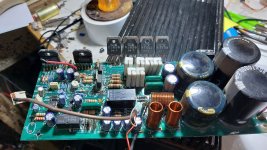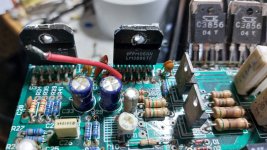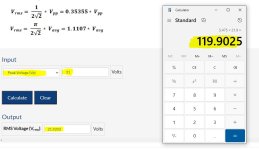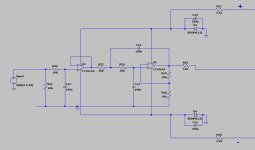Someone gave me one non-functional Yamaha rx-v459 to use for scrap parts. The transformer has 6 wires ( the power ones ) with two ground and two sets of voltages, I think it is wound like double tap transformers for a set of voltages and a few more turns for a higher voltage, I do not know why there is a " selector " in the amp from low to high voltage. ?!?!?.
---------------
- I also took apart one power amp for a active PA 15inch speaker, it had two LM3886 and 4x 120w transistors, I think boosting the power of the LM's from what I've seen on the PCB, not sure if the LM's are in bridge , or one LM is for the tweeter. weird design, also the transformer from that one WAS VERY WEIRD, maybe auto transformer?? in an audio amp??. the secoundary was wired to the primary ( 220v ) on two of the wires, another wires to fuses from the transformer , I took it apart for pure curiosity ( RIP ) , it had only one wire like 0.6mm . Usually in transformers there is the primary with a smaller gauge for mains and the secoundary with thicker wire, this nope, had only one gauge wire for the entire transformer, never seen somethign like this for audio, I will post pictures later. !!!
---------------
- I also took apart one power amp for a active PA 15inch speaker, it had two LM3886 and 4x 120w transistors, I think boosting the power of the LM's from what I've seen on the PCB, not sure if the LM's are in bridge , or one LM is for the tweeter. weird design, also the transformer from that one WAS VERY WEIRD, maybe auto transformer?? in an audio amp??. the secoundary was wired to the primary ( 220v ) on two of the wires, another wires to fuses from the transformer , I took it apart for pure curiosity ( RIP ) , it had only one wire like 0.6mm . Usually in transformers there is the primary with a smaller gauge for mains and the secoundary with thicker wire, this nope, had only one gauge wire for the entire transformer, never seen somethign like this for audio, I will post pictures later. !!!
Attachments
- I also took apart one power amp for a active PA 15inch speaker, it had two LM3886 and 4x 120w transistors, I think boosting the power of the LM's from what I've seen on the PCB, not sure if the LM's are in bridge , or one LM is for the tweeter. weird design, also the transformer from that one WAS VERY WEIRD, maybe auto transformer?? in an audio amp??. the secoundary was wired to the primary ( 220v ) on two of the wires, another wires to fuses from the transformer , I took it apart for pure curiosity ( RIP ) , it had only one wire like 0.6mm . Usually in transformers there is the primary with a smaller gauge for mains and the secoundary with thicker wire, this nope, had only one gauge wire for the entire transformer, never seen somethign like this for audio, I will post pictures later. !!!
Attachments
Transformer is one part of consumer products that is mostly smoke & mirrors. I prefer to buy blown PA amps, which a have a real rating; usually are copper bound, also have the heat sinks case AC conditioning, fan controls etc.
Or new transformers with a rating. I think wgski said you needed something like dual winding 37 vac to produce +-50 v peak, at about 600 va. If your sub amp is 150 w mono, you could get away with a +-37 v 400 va transformer. Apexjr.com has a selection of useful transformers sometimes, or antekinc.com has usual stock. antek has +-15 v windings in addition to main winding to run op amps for filtering, input section, protection circuit, or whatever. My favorite supplier newark is usually cost prohibitive on transformers. Or If you can package one in a RF proof cage, you can buy a switcher supply. Those you buy the DC voltage you want, not voltage/1.4 like transformers. Beware switcher supplies on ebay/alibaba etc they tend to ship without heat sinks and fans, input spike protection blah blah. In case you didn't know 120 vac lines can have 1300 vdc spikes on them from A/C compressor shutoff. All PC's, flat screen TV's etc, have a MOS suppressor and a y rated cap after the breaker/fuse on the front end to absorb the spikes before the 200 v main caps see it.
One reason I won't monkey with NAD, their transformers have weird voltages and frequently show up blown on this board. You almost never hear of a crown or peavey transformer blown. One bargain has been Peavey & Crown warehouse mixer amps, mono, set up for 25 or 70 v transformers on the output, but the power transformer & heatsink are fine. The 180 watt versions would be perfect to power your sub. I've bought them as low as $20 + freight, that have bad solder joints inside that kill the line level signal from the mixer. Or no mixer input boards but the fairly useless telephone interfaces. I think the 75/80 watt version has the same transformer as the 150/180 watt version, just there is one pair output transistors instead of 2, the heatsink and filter caps are smaller. I'm pretty sure about the Peavey, I've never scored the Crown in ebay auction. The warehouse & bar band veterans can be really dirty, but paper towels and Fantastic/409/SpicnSpan are cheap.
Or new transformers with a rating. I think wgski said you needed something like dual winding 37 vac to produce +-50 v peak, at about 600 va. If your sub amp is 150 w mono, you could get away with a +-37 v 400 va transformer. Apexjr.com has a selection of useful transformers sometimes, or antekinc.com has usual stock. antek has +-15 v windings in addition to main winding to run op amps for filtering, input section, protection circuit, or whatever. My favorite supplier newark is usually cost prohibitive on transformers. Or If you can package one in a RF proof cage, you can buy a switcher supply. Those you buy the DC voltage you want, not voltage/1.4 like transformers. Beware switcher supplies on ebay/alibaba etc they tend to ship without heat sinks and fans, input spike protection blah blah. In case you didn't know 120 vac lines can have 1300 vdc spikes on them from A/C compressor shutoff. All PC's, flat screen TV's etc, have a MOS suppressor and a y rated cap after the breaker/fuse on the front end to absorb the spikes before the 200 v main caps see it.
One reason I won't monkey with NAD, their transformers have weird voltages and frequently show up blown on this board. You almost never hear of a crown or peavey transformer blown. One bargain has been Peavey & Crown warehouse mixer amps, mono, set up for 25 or 70 v transformers on the output, but the power transformer & heatsink are fine. The 180 watt versions would be perfect to power your sub. I've bought them as low as $20 + freight, that have bad solder joints inside that kill the line level signal from the mixer. Or no mixer input boards but the fairly useless telephone interfaces. I think the 75/80 watt version has the same transformer as the 150/180 watt version, just there is one pair output transistors instead of 2, the heatsink and filter caps are smaller. I'm pretty sure about the Peavey, I've never scored the Crown in ebay auction. The warehouse & bar band veterans can be really dirty, but paper towels and Fantastic/409/SpicnSpan are cheap.
Last edited:
Real 150W definitely demands more chips to share load, and higher supply voltage.
You can't beat Physics 😎
You can't beat Physics 😎
My guitar amp building colleagues find me sort of weird, even somewhat masochist, because I suffer self building components they buy ready made with WAY less complication.Transformer is one part of consumer products that is mostly smoke & mirrors. I prefer to buy blown PA amps, which a have a real rating; usually are copper bound, also have the heat sinks case AC conditioning, fan controls etc.
I mean transformers, chassis, speakers, even cabinets.
Fine, to each his own.
But self building offers:
- Unbeatable cost
- Really know what is being used
- Often specs not easily available in the general market or available suppliers
- Agree that building anything takes time BUT many times saving days or weeks waiting for delivery
Doing the balance, well worth it.
All my transformers are low loss.
After testing many variations, found that biggest loss is resistive, from copper wire DCR , more than anything else, so much prefer to use square bobbins if possible (shortest average turn path) and always fill laminations to the brim, investing in Copper is well worth it.
Using good silicon steel is also worth it.
In my big power amps, fan also cools transformer bobbin 😱 , found that after 2-3 hours full power duty (common in Rock Festivals or simply all night Club use) bobbin overheating causes unbearable supply rails drop.
This is ignored by most, who test an amp for 15-30 minutes tops on the Lab bench and are happy with what they find.
Just let them cook overnight at a burn-in rack .... Surprise surprise! 🙂
First of all: I find this thread very interesting: this type of amplifier is exactly what I have been looking for: a simple powerful workhorse for 4 Ohm (nominal) subs-to-100Hz-only.
However: in the discussion about most suitable devices for the power (driver?) stage I somewhat lost track.
Is it much to ask to show the schematic once more, but now with the prosed most suitable transistor types for each stage aiming for some 120 W Rms in 4 Ohms and some +-40-45 V power supply? An alternative would be simply listing the transistors by type & power-supply requirements, as member Elvee did with his Circlotron variations.
However: in the discussion about most suitable devices for the power (driver?) stage I somewhat lost track.
Is it much to ask to show the schematic once more, but now with the prosed most suitable transistor types for each stage aiming for some 120 W Rms in 4 Ohms and some +-40-45 V power supply? An alternative would be simply listing the transistors by type & power-supply requirements, as member Elvee did with his Circlotron variations.
This is my final schematic, included low pass 18dB/ octave at 160hz . from here https://sound-au.com/project123.htm
For +-35v I used 2sc1815/2sa1015 , BD139 for Vas , and output trans MJ11015/MJ11016 .
Quiss current 80 - 100mA.
Measured output 24V (Couldn't go higher due to mechanically limits of my test sub. ) on 4ohm load, ( around 140w ?). +-35rails .
For higher rail voltages u can use almost any PNP / NPN .
BC546/556 for 40 - 45 v rails could work.
MPSA42 - MPSA92
MPSA44 - MPSA94
2n5551 - 2n5401
for VAS, anything with high voltage, hFE 50+ .
For +-35v I used 2sc1815/2sa1015 , BD139 for Vas , and output trans MJ11015/MJ11016 .
Quiss current 80 - 100mA.
Measured output 24V (Couldn't go higher due to mechanically limits of my test sub. ) on 4ohm load, ( around 140w ?). +-35rails .
For higher rail voltages u can use almost any PNP / NPN .
BC546/556 for 40 - 45 v rails could work.
MPSA42 - MPSA92
MPSA44 - MPSA94
2n5551 - 2n5401
for VAS, anything with high voltage, hFE 50+ .
Attachments
24 volts RMS requires 34 volts peak. You wont get that off 35 volt rails. 32 if you’re lucky, and if REGULATED. 24 volts peak is 17 RMS, or 72 watts. You might get a little more than that, but not much.
If that is all the sub will take before bottoming out there isn’t much point in going for more watts. I’m guessing it’s not a big pro 15” or car “superwoofer”.
If that is all the sub will take before bottoming out there isn’t much point in going for more watts. I’m guessing it’s not a big pro 15” or car “superwoofer”.
@wg_ski my cheap 8 inch test subwoofer was bottoming out, I don't test on my good speakers .
his 10" sounds beautifully with this amp, we listened for hours yesterday,I'm quite happy with the result. and so is he !.
Maybe I should've used other LTP, CCS, mirror transistors , for higher rails 40 -45 v , but there's plenty of power as it is now .
his 10" sounds beautifully with this amp, we listened for hours yesterday,I'm quite happy with the result. and so is he !.
Maybe I should've used other LTP, CCS, mirror transistors , for higher rails 40 -45 v , but there's plenty of power as it is now .
@xXBrunoXx: thank you very much.
A different point: is the amp stable enough to include the required high- and low pass filtering in the power-amp feedback loop, instead of having a separate filter section preceding the power-amp?
A different point: is the amp stable enough to include the required high- and low pass filtering in the power-amp feedback loop, instead of having a separate filter section preceding the power-amp?
@Boden I haven't tested in real life but, in LTSpice it seems ok, 50n in parallel with R11 (27k Feedback res ) would do.
But the filter is simple enough to be built, can be powered by the rails with two 12 or 15v zeners , two 100uF caps and two 1 - 2.2k 1-2W resistors.
But the filter is simple enough to be built, can be powered by the rails with two 12 or 15v zeners , two 100uF caps and two 1 - 2.2k 1-2W resistors.
Attachments
Multimeter? With what as a source? With music you could be reading almost anything. A low frequency sine wave and readings become believable. It’s easy to get 60 Hz (Find a little transformer and put a pot on the secondary). And the meter is accurate enough too at the frequency it was intended.@wg_ski I don't know , my multimeter showed 24v max , average 20 - 22.
With a sine wave right at clipping one could expect 24 VAC (RMS) if the supply stayed right up at 35 volts. It would take about a 600 VA toroid, maybe even 1000 to be stiff enough not to drop more than a volt or two. What does the DC read, as well as the AC output?
And did you START with 35V rails, or are you using a 2x35V transformer? That would put the DC at 50V - and 50V caps might be a little over with no load.
I get believeable repeatable vac readings on music with an analog AC voltmeter. MIne has 20 vac and 100 vac scales. If this is a RMS digital meter the 24 VAC reading could be right.Multimeter? With what as a source? With music you could be reading almost anything. A low frequency sine wave and readings become believable. It’s easy to get 60 Hz (Find a little transformer and put a pot on the secondary). And the meter is accurate enough too at the frequency it was intended.
I get random numbers on music with my several digital AC voltmeters. However, if xxbrunoxx has a sub filter in front of his amp, like a crossover appliance, then frequencies from 40-100 hz from music could produce a decent reading on a DVM.
It just seems impossible to believe that you read 24V AC with music on a DMM with only 35V DC supply. There just isn’t enough sustained power to do it. A sine wave, yeah. At that full voltage on the supply. But if one starts with 35 VDC unloaded and it drops to 30 if you’re lucky, a 24V reading again becomes unlikely. A 35-0-35 V transformer delivers a lot more - and you really would be able to push 150 real watts at 4 ohms. You will have at least 35V, even if the trafo is 10X overloaded. It would start to get hard on MJ11015’s though, as you would be hitting 12.5A at 25V, and likely around 4, repetitvely, at the full 50 V - which is available more often statistically than the full load volts. That’s beyond the second breakdown limits. It will do it for a while, but not forever. Run it too hot like that and you’ll short the outputs.
Bruno needs to clarify how exactly he’s making the measurement, and what the power supply really consists of. If it’s a regulated 35V SMPS that can deliver the full 8 amps peak without going into a hiccup mode (or exploding with long term use at that current, repetitively) that would give the best possible result.
Bruno needs to clarify how exactly he’s making the measurement, and what the power supply really consists of. If it’s a regulated 35V SMPS that can deliver the full 8 amps peak without going into a hiccup mode (or exploding with long term use at that current, repetitively) that would give the best possible result.
I'm not sure the reading is 100% correct.
Yes:
Transformer is 26v - 0 - 26v 5 amp per rail. Two big 10.000uf caps 80v.
Yes:
Also, used my phone as signal generator, tried 40hz, 50hz.However, if xxbrunoxx has a sub filter in front of his amp, like a crossover appliance, then frequencies from 40-100 hz from music could produce a decent reading on a DVM.
Transformer is 26v - 0 - 26v 5 amp per rail. Two big 10.000uf caps 80v.
Vac, so around 36 after rectification26v - 0 - 26v 5 amp per rail
- Home
- Amplifiers
- Solid State
- Simple Sub amp

